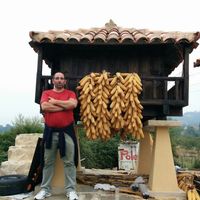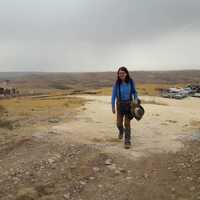Papers by Gisela Cassiodoro

La posibilidad de asignar una cronología a las representaciones rupestres efectuadas a través de ... more La posibilidad de asignar una cronología a las representaciones rupestres efectuadas a través de la técnica del grabado es objeto de discusión desde los inicios de la arqueología patagónica. En esta nota se
presenta información que permite ampliar dicha problemática al caracterizar un sello arqueológico sobre grabados registrado en el sitio Cañadón Guitarra 3 localizado en la meseta del lago Guitarra (provincia de
Santa Cruz, Argentina). Se describen los motivos grabados y su asociación con la tecnología y fechados de la excavación. La cronología absoluta establece una fecha mínima de ejecución hace 1.200 años
AP. De esta manera, el sello arqueológico y las evidencias asociadas sugieren una asignación temporal de los motivos aquí discutidos acotada al Holoceno medio y al Holoceno tardío inicial. De este modo, esta información también contribuye, en distintas escalas, al conocimiento del proceso de poblamiento humano en las mesetas altas de Santa Cruz.

Circulation of Goods and Information in Southern Patagonia During the Late Holocene: An Integrated Analysis of Engravings and Black Obsidian Artefacts
Journal of World Prehistory, 2024
This paper explores the strategies implemented by hunter-gatherer groups in Southern Patagonia du... more This paper explores the strategies implemented by hunter-gatherer groups in Southern Patagonia during the Late Holocene in relation to the circulation of goods and information. Previous archaeological investigations have revealed important changes in human mobility and land-use patterns during this period, associated with increasingly dry environmental conditions. In this context, we undertake a broad spatial scale analysis of the circulation of goods and information through the integrated examination of two lines of evidence: rock art and lithic raw materials. Specifically, we consider the distribution of engravings and black obsidian artefacts assigned to the Late Holocene. The former can offer certain insights into the circulation of information, and the latter are indicative of the circulation of goods. Our analysis suggests that during this period different strategies were developed by hunter-gatherer groups to face the changing environment. Several implications concerning social interaction and the movement of people during this period in Southern Patagonia are discussed.

ANTHROPOZOOLOGICA, Jul 12, 2024
The aim of this paper is to discuss the role of faunal remains in funerary contexts from Southern... more The aim of this paper is to discuss the role of faunal remains in funerary contexts from Southern Patagonia. We will particularly emphasize the information obtained in mortuary contexts from Lake Salitroso (Santa Cruz Province, Argentina). In this area a total of 37 burials of different types, such as chenques (i.e. artificial rock burial mounds), burial under blocks and niches, have been studied. Results indicate low frequency of animal remains, mostly corresponding to fox (Lycalopex Burmeister, 1856) and guanaco (Lama guanicoe Müller, 1776). Additionally, certain variability in skeletal part representation has been detected. These characteristics are not reflected in the documentary sources of first European explorers in Patagonia, but are common in the regional archaeological record. Finally,
another outcome of interest is the presence of animal remains deposited by natural processes (rodents, edentates and carnivores). The results are contextualized with available regional ethnohistoric and archaeological information to discuss the role of animal species in the funerary practices of hunter-gatherer populations in southern Patagonia.
Arqueología de Fuego- Patagonia. Levantando piedras, desenterrando huesos...y develando arcanos, 2007
El análisis comparativo del registro lítico es realizado desde dos aspectos. Por un lado, se foca... more El análisis comparativo del registro lítico es realizado desde dos aspectos. Por un lado, se focaliza en establecer las posibles diferencias en el uso del espacio interno y externo de las estructuras y por otro, se centra en dar cuenta de la variabilidad relacionada con la localización altitudinal de los parapetos dentro del sitio. Es esta última la que presenta un mayor aporte, permitiendo ampliar la discusión sobre las características de la utilización de estas estructuras.

La variabilidad morfológica en raspadores en el centro-oeste de Santa Cruz, Patagonia meridional.... more La variabilidad morfológica en raspadores en el centro-oeste de Santa Cruz, Patagonia meridional. Su evaluación en términos temporales Endscrapers morphological variability in central-western of Santa Cruz province, Southern Patagonia. A temporal evaluation Resumen En este trabajo evaluamos comparativamente raspadores del Holoceno medio y tardío del centro-oeste de Santa Cruz (Patagonia) a los fines de discutir acerca de la variabilidad de los conjuntos en el contexto de cambios ambientales que se dieron durante el Holoceno. Dicha comparación abarca escalas espaciales y temporales amplias y se realiza sobre la base de variables morfológicas y métricas. Los resultados indican que no existen diferencias significativas entre los raspadores de uno y otro período a excepción del espesor de aquellos confeccionados en sílice. Se discuten las implicancias en términos de las estrategias implementadas por los cazadores-recolectores en contextos ambientales específicos.
núcleos tomando en cuenta variables como frecuencia, estado, dimensiones, tipos de núcleos y pres... more núcleos tomando en cuenta variables como frecuencia, estado, dimensiones, tipos de núcleos y presencia de corteza. Se concluye que la distancia a la fuente no explica todos los patrones observados, contribuyendo a la discusión sobre las estrategias involucradas en el transporte y explotación de la obsidiana en una escala espacial amplia.

RESUMEN. En el centro-oeste de la provincia de Santa Cruz (Argentina) las puntas de proyectil que... more RESUMEN. En el centro-oeste de la provincia de Santa Cruz (Argentina) las puntas de proyectil que predominan desde el Holoceno temprano hasta el Holoceno medio se corresponden con una morfología que no presenta pedúnculo. Por tal razón, este diseño apedunculado ha sido considerado como un fósil guía para la asignación cronológica de contextos arqueológicos. En este trabajo se presentan las características de esta clase artefactual recuperada en diferentes sectores de la región de estudio. Se aborda su distribución espacial, las cronologías absolutas y relativas asignadas, las materias primas utilizadas y aspectos de su morfología. Estas puntas están heterogéneamente distribuidas, se asignan a cronologías previas a los 2000 años AP, predomina el uso de la obsidiana negra y se registra variabilidad en morfologías. El análisis de las puntas apedunculadas nos permite discutir algunas cuestiones del poblamiento humano desde el comienzo del Holoceno y su trayectoria temporal posterior.
δ13C and δ15N in organic residues of Patagonia pottery. Implications for studies of diet and subsistence strategies among late Holocene hunter-gatherers
Journal of Archaeological Science: Reports
There is still debate about when and how the peopling process of South America developed, particu... more There is still debate about when and how the peopling process of South America developed, particularly in southern Patagonia. Earliest evidence corresponds to chronologies beginning at circa 11,000 radiocarbon years ago. Regarding the archaeological record, discussions about early peopling often have been related to the existence of a particular type of projectile point: the fishtail point. This work aims to evaluate the initial peopling of southern Patagonia by mainly focusing on the processes which operated in central-western Santa Cruz province (Argentina). We analyze the distributions of fishtail points as well as stemless projectile points, which also could be related to early occupation contexts. Likewise, other evidence is considered, such as the differential use of black obsidian coming from the important source of Pampa del Asador.
Comechingonia, 2019
There is a high frequency of stone structures called parapetos in plateaus from Patagonia. The an... more There is a high frequency of stone structures called parapetos in plateaus from Patagonia. The analysis of these structures and the artefactual assemblages related to them are relevant to study the characteristics of the occupation of this kind of environments. Thus, we seek to evaluate the variability of a group of 11 hunting blinds from site Guitarra 10 (Lake Guitarra plateau, Santa Cruz province, Argentina). A comparative analysis of lithic technology is carried out based on two aspects. Firstly, we evaluate possible differences in the use of the internal and external space of the structures. Secondly, we assess the variability related to the altitudinal location of the hunting blinds. The latter has allowed discussing the use of structures to a greater extent.
Relaciones de la SAA, 2019
En los últimos años, a través del uso de la teledetección, se iniciaron los relevamientos en el s... more En los últimos años, a través del uso de la teledetección, se iniciaron los relevamientos en el sector oeste de la meseta del lago Guitarra registrando la presencia de 17 estructuras de piedra en una superficie observada de 4 km (Dellepiane 2018). Un conjunto de ellas fue posteriormente relevado en campo. Uno de los objetivos de esta nota es presentar los resultados obtenidos de la caracterización general de dichas estructuras y del material lítico asociado. Al mismo tiempo, se detallarán nuevos hallazgos realizados mediante la utilización de imágenes satelitales en el sector occidental de la meseta. Esta nueva información permite seguir profundizando el conocimiento que se tiene sobre el uso de los espacios mesetarios que habrían efectuado las poblaciones cazadoras-recolectoras de la región.

Intersecciones en Antropología, 2018
In this paper the results of a study of the use of pottery technology by hunter-gatherers from
ce... more In this paper the results of a study of the use of pottery technology by hunter-gatherers from
central-west Santa Cruz, Argentina, towards the end of the Late Holocene are presented. The results of C and
N stable isotope (EA-IRMS) and chemical (GC-MS) analyses of organic residues recovered from archaeological
sherds are reported. Stable isotope data indicates that the origin of the adhered organic residues is from steppe
animals. In addition, the fatty acid profiles of the archaeological samples were very similar to guanaco (Lama
guanicoe), particularly linear and branched odd fatty acids, which are potential lipid biomarkers of ruminants
and pseudo-ruminants. Most samples had cholesterol. None showed vegetable oils in the absorbed lipid residues.
Hence, the archaeometrical evidence points towards the use of pottery for the extraction of guanaco fat by
hunter-gatherer groups of central-west Santa Cruz.

The main aim of this paper is to evaluate if certain processes that were documented in a specific... more The main aim of this paper is to evaluate if certain processes that were documented in a specific area of Central-Southern Patagonia during the Late Holocene were also registered in a broader spatial scale. Previous investigations carried out in our study area located in Central-Western Santa Cruz province, Patagonia, have stated that climatic fluctuations during the Late Holocene (last 2500 years) were the cause of a reduction of hunter-gatherers' residential mobility. The new climatic conditions were characterized by important environmental droughts, which increased during the Mediaeval Climatic Anomaly, circa 900 years BP. This reduction in mobility resulted in concentrations of populations in low altitude basins and increased logistical and seasonal mobility, defined as a process of extensification. In this paper we take a broad spatial perspective to evaluate to what extent the low residential mobility identified in our research area had a correlation in a larger regional scale. Also we assess if this lead to a regional differentiation among hunter-gatherer populations, previous to European contact (450 years BP). In order to achieve these aims, we undertake a coarse grain analysis, using available data published on the composition and distribution of the archaeological record for Central-Southern Pata-gonia, an area of about 450.000 km 2. Specifically, we consider evidence about technology, zooarch-aeology, rock art, mortuary record and paleodietary studies. The analysis indicates that a reduced residential mobility could have occurred in certain areas of the study region, linked to the aforementioned climatic changes. On the issue of regional differentiation, the archaeological record highlights the complexity of this process. There are a variety of arguments both for and against the idea of a process of regionalization in Central-Southern Patagonia in the Late Holocene. We propose a process of differentiation of populations with low residential mobility which nonetheless remained connected through the circulation of goods, information and people.
Problemáticas de la Arqueología Contemporánea, 2008
A pesar que en distintos contextos arqueológicos de la Patagonia se ha evidenciado la presencia d... more A pesar que en distintos contextos arqueológicos de la Patagonia se ha evidenciado la presencia de cerámica, el análisis sistemático de la misma ha sido poco abordado para la región. Consideramos relevante caracterizar cuál habría sido el papel de esta tecnología en grupos cazadores recolectores de Patagonia, dado que la cerámica tiende a estar en relación con poblaciones poco móviles. De esta manera, uno de los objetivos del trabajo es realizar una aproximación al estudio de la tecnología cerámica en el noroeste de la provincia de Santa Cruz.
En esta primera instancia, se tendrá en cuenta la distribución, frecuencia y características macroscópicas generales del material cerámico de la cuenca de los lagos Salitroso y Posadas, el Cerro Pampa, el Parque Nacional Perito Moreno y la cuenca de los lagos Cardiel y Strobel.
A comparative technological analysis of two stratified sites located in midwest Santa
Cruz provin... more A comparative technological analysis of two stratified sites located in midwest Santa
Cruz province highlands (Argentina) is carried on. This article presents information
about the lithic assemblages from Alero Destacamento Guardaparque (Perito Moreno
National Park) and Cañadón Guitarra 3 (Lake Guitarra Plateau) sites, dated to Middle
and Late Holocene. Considering fluctuating environmental conditions, this paper
aims to assess the extent to which variations in water availability within the landscape
would have modified the role of these sites within mobility routes, as well as the access
and use of lithic resources. Information is provided about the technological aspects
that changed through time and space and those which remained constant. Thus, this
paper contributes to discussions about mobility and land use by human populations
in Patagonia.

RESUMEN Los análisis de elementos traza se utilizan para clasificar las rocas y reconocer el orig... more RESUMEN Los análisis de elementos traza se utilizan para clasificar las rocas y reconocer el origen y evolución de los sistemas magmáticos, ya que pueden ser especificados sobre la base del comportamiento geoquímico. Algunos de estos sistemas se manifiestan en los plateau basálticos del centro oeste de Santa Cruz (Argentina), a través de remanentes de rocas lávicas basálticas, como mantos o cuellos volcánicos, muy compactos. Se presentan, a modo exploratorio, los resultados de los análisis de elementos traza sobre muestras geológicas y de artefactos arqueológicos de basaltos provenientes de diferentes cuencas lacustres y mesetas en el centro oeste de Santa Cruz. Se identifican trazadores preferenciales con el objetivo de reconocer las potenciales fuentes naturales y/o canteras arqueológicas en el área. Estos son los primeros datos para la región y se utilizan en la interpretación de estrategias de aprovisionamiento y distribución de esta roca, seguidas por poblaciones cazadoras-recolectoras durante el Holoceno. Palabras clave: basalto-elementos traza-canteras arqueológicas-estrategias de aprovisionamiento-Santa Cruz BASALT TRACE ELEMENTS AT CORDILLERA AND PRECORDILLERA IN SANTA CRUZ (ARGENTINA). ITS USE IN ARCHAEOLOGICAL QUARRIES LOCALIZATION ABSTRACT Trace element compositions are used to classify rocks and constrain the origin and evolution of magmatic systems, since different elements have different geochemical behavior. Such systems are manifested in the basaltic plateaus of central-west Santa Cruz (Argentina), through remnants of basaltic lava rocks or volcanic necks. The results of the analysis of trace elements on geological samples of basalts and basaltic archaeological artifacts from different lacustrine basins and plateaus in the west-center of Santa Cruz are presented. Preferential tracer elements are identified with the objective of recognizing the potential natural sources and / or archaeological quarries in the area. These are the first data for basalts in the region and are used in the interpretation of the distribution of this rock and the supply strategies followed by hunter-gatherer populations during the Holocene.

Paleoamerica
In the steppe and forest ecotone of central-western Santa Cruz province, Argentina, there are thr... more In the steppe and forest ecotone of central-western Santa Cruz province, Argentina, there are three lithic raw materials whose primary and secondary sources have been recognized. These are the obsidian, the siltstone, and a silicified green tuff. Moreover, the characteristics of their use during the late Holocene are well known. In this paper, we evaluate diagnostic and comparative information regarding their use during the early stages of hunter-gatherer settlement in this southern region. The analysis is based on debitage, tools, and cores recovered in contexts with early and middle Holocene chronologies from the low basins of Tar, San Martín, and Cardiel lakes as well as the highlands of the Guitarra plateau and Perito Moreno National Park. We also discuss the importance of these knappable materials in the human settlement processes and the initial learning of the landscape.

RESUMEN La meseta del Strobel (provincia de Santa Cruz) se caracteriza por una alta frecuencia de... more RESUMEN La meseta del Strobel (provincia de Santa Cruz) se caracteriza por una alta frecuencia de repre-sentaciones rupestres grabadas como también por un elevado número de estructuras de parape-tos, más de 300 registradas hasta el momento, que evidencian el equipamiento y programación tecnológica de este espacio. En este panorama, se destaca el sitio K116, localizado en la porción norte de la meseta, consistente en un conjunto agrupado de 55 parapetos en un área acotada. Otra particularidad de este conjunto es que incluye diferentes tamaños y formas de los parapetos. Asi-mismo, se observa variabilidad en las ubicaciones altitudinales, conjuntos artefactuales y restos arqueofaunísticos asociados. A partir de esta caracterización se discuten diferentes estrategias de caza y su vinculación con la movilidad de las poblaciones cazadoras durante el Holoceno tardío. De tal modo, se busca ampliar la discusión sobre el rol de las mesetas basálticas en los procesos poblacionales de la región, bajo condiciones climático/ambientales cambiantes. ABSTRACT The Strobel plateau (Santa Cruz province) is characterized by the high frequencies of engraved motifs as well as by the great amount of hunting blinds. More than 300 have been documented up to the moment and thus, provide evidence of the technological equipment and scheduled use of this space. In this context, site K116 stands out. It is located in the northern part of the plateau and consists of a group of 55 hunting blinds in a relatively small area. Another characteristic of this group of structures is that it includes different sizes and forms of hunting blinds. Moreover, there is variability in the altitudinal locations and in the artefactual assemblages and archaeofaunistic remains related to them. Based on these descriptions different hunting strategies are discussed as well as their relation with the hunters gatherers´mobilitygatherers´mobility during the late Holocene. Therefore, this work seeks to broaden the discussion about the role basaltic plateaus played in the peopling process of the region under changing environmental conditions.











Uploads
Papers by Gisela Cassiodoro
presenta información que permite ampliar dicha problemática al caracterizar un sello arqueológico sobre grabados registrado en el sitio Cañadón Guitarra 3 localizado en la meseta del lago Guitarra (provincia de
Santa Cruz, Argentina). Se describen los motivos grabados y su asociación con la tecnología y fechados de la excavación. La cronología absoluta establece una fecha mínima de ejecución hace 1.200 años
AP. De esta manera, el sello arqueológico y las evidencias asociadas sugieren una asignación temporal de los motivos aquí discutidos acotada al Holoceno medio y al Holoceno tardío inicial. De este modo, esta información también contribuye, en distintas escalas, al conocimiento del proceso de poblamiento humano en las mesetas altas de Santa Cruz.
another outcome of interest is the presence of animal remains deposited by natural processes (rodents, edentates and carnivores). The results are contextualized with available regional ethnohistoric and archaeological information to discuss the role of animal species in the funerary practices of hunter-gatherer populations in southern Patagonia.
central-west Santa Cruz, Argentina, towards the end of the Late Holocene are presented. The results of C and
N stable isotope (EA-IRMS) and chemical (GC-MS) analyses of organic residues recovered from archaeological
sherds are reported. Stable isotope data indicates that the origin of the adhered organic residues is from steppe
animals. In addition, the fatty acid profiles of the archaeological samples were very similar to guanaco (Lama
guanicoe), particularly linear and branched odd fatty acids, which are potential lipid biomarkers of ruminants
and pseudo-ruminants. Most samples had cholesterol. None showed vegetable oils in the absorbed lipid residues.
Hence, the archaeometrical evidence points towards the use of pottery for the extraction of guanaco fat by
hunter-gatherer groups of central-west Santa Cruz.
En esta primera instancia, se tendrá en cuenta la distribución, frecuencia y características macroscópicas generales del material cerámico de la cuenca de los lagos Salitroso y Posadas, el Cerro Pampa, el Parque Nacional Perito Moreno y la cuenca de los lagos Cardiel y Strobel.
Cruz province highlands (Argentina) is carried on. This article presents information
about the lithic assemblages from Alero Destacamento Guardaparque (Perito Moreno
National Park) and Cañadón Guitarra 3 (Lake Guitarra Plateau) sites, dated to Middle
and Late Holocene. Considering fluctuating environmental conditions, this paper
aims to assess the extent to which variations in water availability within the landscape
would have modified the role of these sites within mobility routes, as well as the access
and use of lithic resources. Information is provided about the technological aspects
that changed through time and space and those which remained constant. Thus, this
paper contributes to discussions about mobility and land use by human populations
in Patagonia.
presenta información que permite ampliar dicha problemática al caracterizar un sello arqueológico sobre grabados registrado en el sitio Cañadón Guitarra 3 localizado en la meseta del lago Guitarra (provincia de
Santa Cruz, Argentina). Se describen los motivos grabados y su asociación con la tecnología y fechados de la excavación. La cronología absoluta establece una fecha mínima de ejecución hace 1.200 años
AP. De esta manera, el sello arqueológico y las evidencias asociadas sugieren una asignación temporal de los motivos aquí discutidos acotada al Holoceno medio y al Holoceno tardío inicial. De este modo, esta información también contribuye, en distintas escalas, al conocimiento del proceso de poblamiento humano en las mesetas altas de Santa Cruz.
another outcome of interest is the presence of animal remains deposited by natural processes (rodents, edentates and carnivores). The results are contextualized with available regional ethnohistoric and archaeological information to discuss the role of animal species in the funerary practices of hunter-gatherer populations in southern Patagonia.
central-west Santa Cruz, Argentina, towards the end of the Late Holocene are presented. The results of C and
N stable isotope (EA-IRMS) and chemical (GC-MS) analyses of organic residues recovered from archaeological
sherds are reported. Stable isotope data indicates that the origin of the adhered organic residues is from steppe
animals. In addition, the fatty acid profiles of the archaeological samples were very similar to guanaco (Lama
guanicoe), particularly linear and branched odd fatty acids, which are potential lipid biomarkers of ruminants
and pseudo-ruminants. Most samples had cholesterol. None showed vegetable oils in the absorbed lipid residues.
Hence, the archaeometrical evidence points towards the use of pottery for the extraction of guanaco fat by
hunter-gatherer groups of central-west Santa Cruz.
En esta primera instancia, se tendrá en cuenta la distribución, frecuencia y características macroscópicas generales del material cerámico de la cuenca de los lagos Salitroso y Posadas, el Cerro Pampa, el Parque Nacional Perito Moreno y la cuenca de los lagos Cardiel y Strobel.
Cruz province highlands (Argentina) is carried on. This article presents information
about the lithic assemblages from Alero Destacamento Guardaparque (Perito Moreno
National Park) and Cañadón Guitarra 3 (Lake Guitarra Plateau) sites, dated to Middle
and Late Holocene. Considering fluctuating environmental conditions, this paper
aims to assess the extent to which variations in water availability within the landscape
would have modified the role of these sites within mobility routes, as well as the access
and use of lithic resources. Information is provided about the technological aspects
that changed through time and space and those which remained constant. Thus, this
paper contributes to discussions about mobility and land use by human populations
in Patagonia.